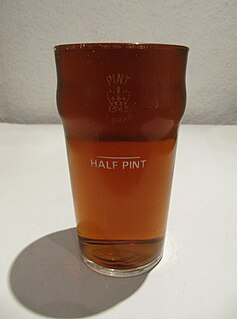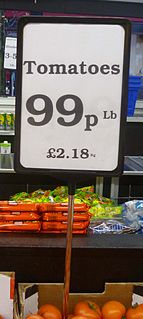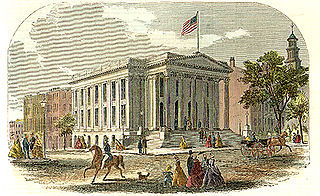
The imperial system of units, imperial system or imperial units is the system of units first defined in the British Weights and Measures Act 1824 and continued to be developed through a series of Weights and Measures Acts and amendments. The imperial units replaced the Winchester Standards, which were in effect from 1588 to 1825. The system came into official use across the British Empire in 1826. By the late 20th century, most nations of the former empire had officially adopted the metric system as their main system of measurement, but imperial units are still used in the United Kingdom and some other countries formerly part of the British Empire. The imperial system developed from what were first known as English units, as did the related system of United States customary units.

Metrication or metrification is the act or process of converting to a metric system of measurement. All over the world, nations have transitioned from their local and traditional units of measurement to the metric system. This process began in France during the 1790s and continues more than two centuries later. The metric system has not been fully adopted in all countries and sectors.

In recipes, quantities of ingredients may be specified by mass, by volume, or by count.

The pint is a unit of volume or capacity in both the imperial and United States customary measurement systems. In both of those systems it is traditionally one eighth of a gallon. The British imperial pint is about 20% larger than the American pint because the two systems are defined differently. Almost all other countries have standardized on the metric system, so the size of what may be called a pint varies depending on local custom.
Long ton, also known as the imperial ton or displacement ton, is the name for the unit called the "ton" in the avoirdupois system of weights or Imperial system of measurements. It was standardised in the thirteenth century. It is used in the United Kingdom and several other British Commonwealth of Nations countries alongside the mass-based metric tonne defined in 1799, as well as in the United States for bulk commodities.

A tape measure or measuring tape is a flexible ruler used to measure size or distance.
The Metrication Board was a non-departmental public body that existed in the United Kingdom to promote and co-ordinate metrication within the country. It was set up in 1969, four years after the metrication programme was announced, and wound down in 1981.

The US Metric Association (USMA), based in Windsor, Colorado, is a non-profit organization that advocates for total conversion of the United States to the International System of Units (SI). Founded on 27 December 1916 at Columbia University in New York City, it was originally called the American Metric Association. The USMA publishes a bi-monthly newsletter for its members on the state of the metric system in the United States: Metric Today.
A system of measurement is a collection of units of measurement and rules relating them to each other. Systems of measurement have historically been important, regulated and defined for the purposes of science and commerce. Systems of measurement in use include the International System of Units (SI), the modern form of the metric system, the British imperial system, and the United States customary system.
The Metric Martyrs were a British advocacy group who campaigned for the freedom to choose what units of measurement are used by traders. The group believed that vendors should have the freedom to mark their goods with imperial weights and measurements alone. This opposes the current legal position that imperial units may be used so long as metric units are also displayed.

The UK Metric Association, or UKMA, is an advocacy group in the United Kingdom that argues for Metrication in the United Kingdom and advocates the use of the metric system among the general public in the UK. UKMA argues that the continued use of two incompatible systems of measurement causes misunderstanding, confusion and mistakes, undermines consumer protection, wastes time during children's education, results in additional costs, and is against the national interest.
The spread of metrication around the world in the last two centuries has been met with both support and opposition.

Metrication in Canada began in 1970 and ceased in 1985. While Canada has converted to the metric system for many purposes, there is still significant use of non-metric units and standards in many sectors of the Canadian economy and everyday life today. This is mainly due to historical ties with the United Kingdom, the traditional use of the imperial system of measurement in Canada, proximity to the United States, and strong public opposition to metrication during the transition period.

Metrication in Australia effectively began in 1966 with the conversion to decimal currency under the auspices of the Decimal Currency Board. The conversion of measurements—metrication—commenced subsequently in 1971, under the direction of the Metric Conversion Board and actively proceeded until the Board was disbanded in 1981.

Metrication in the United Kingdom, the process of introducing the metric system of measurement in place of imperial units, has made steady progress since the mid–20th century but today remains equivocal and varies by context. Most of government, industry and commerce use metric units, but imperial units are officially used to specify journey distances, vehicle speeds and the sizes of returnable milk containers, beer and cider glasses. Imperial units are also often used to describe body measurements and vehicle fuel economy. In schools metric units are taught and used as the norm. Imperial units that remain in common usage in the UK are also taught.

Metrication in the Republic of Ireland happened mostly in the 20th century and was officially completed in 2005, with a few exceptions.

New Zealand started metrication in 1969 with the establishment of the Metric Advisory Board (MAB) and completed metrication on 14 December 1976. Until the 1970s, New Zealand traditionally used the imperial system for measurement, which it had inherited from the United Kingdom.

As of 2009, the European Union had issued two units of measurement directives: In 1971 it issued Directive 71/354/EEC which required EU member states to standardise on the International System of Units (SI) rather than use a variety of CGS and MKS units then in use. The second, which replaced the first, was Directive 80/181/EEC made in 1979 and amended in 1984, 1989, 2000 and 2009. It issued a number of derogations to the United Kingdom and Ireland based on the former directive.

The following outline is provided as an overview of and topical guide to the metric system – various loosely related systems of measurement that trace their origin to the decimal system of measurement introduced in France during the French Revolution.

The imperial and US customary measurement systems are both derived from an earlier English system of measurement which in turn can be traced back to Ancient Roman units of measurement, and Carolingian and Saxon units of measure.














